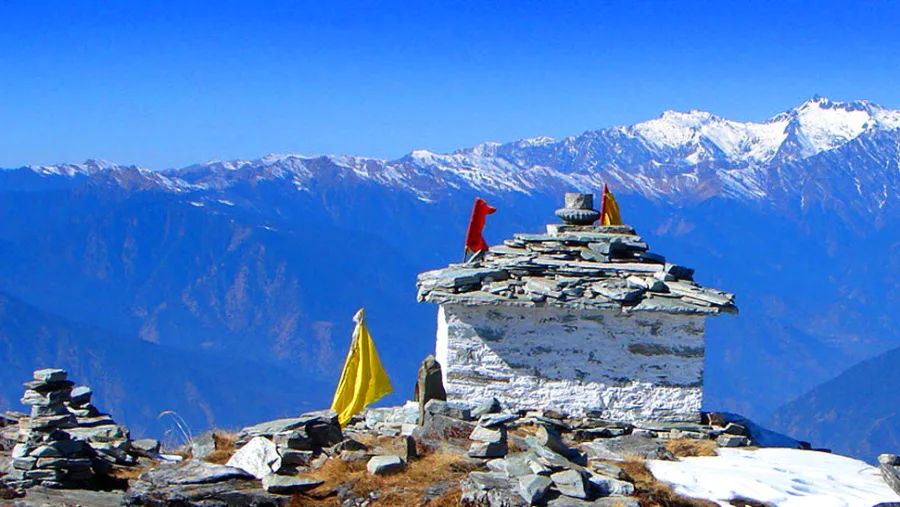Chopta Chandrashila Trek : The Chandrashila Trek is one of Uttarakhand’s most scenic and rewarding short treks, offering stunning views of Himalayan giants like Nanda Devi and Chaukhamba. Starting from Chopta and passing through Tungnath—the highest Shiva temple in the world—it’s a journey that combines natural beauty with spiritual depth.The Chopta Tungnath trek is a perfect blend of natural beauty and spiritual experience in the Garhwal Himalayas. Starting from the scenic village of Chopta, the trail leads you through dense forests and lush meadows to Tungnath, the highest Shiva temple in the world. This moderately easy trek is ideal for beginners and offers stunning views of snow-capped Himalayan peaks, making it one of the most rewarding short treks in Uttarakhand.
Trekking in the Himalayas has always been a dream of mine. The majestic peaks, the serene landscapes, and the thrill of conquering challenging trails have a unique allure. One winter, I decided to embark on the Chopta Chandrashila trek in December, an adventure I had been eagerly anticipating. This blog is a detailed account of my solo journey, highlighting the mesmerizing beauty of Chopta in December, the thrilling trek to Chandrashila, and the camping experience that made it all the more memorable.
My journey began in early December when I arrived in Chopta, a picturesque hill station in Uttarakhand, India. Chopta is renowned for its breathtaking views, lush green meadows, and dense forests, which transform into a winter wonderland as the temperatures drop. The entire region was blanketed in a pristine layer of snow, creating a postcard-worthy landscape.
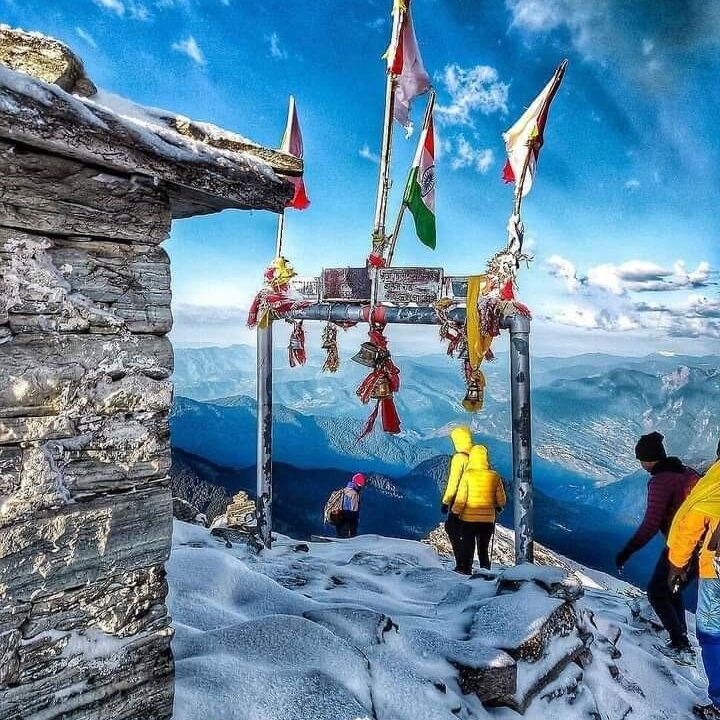
Itinerary Breakdown: From Chopta to Chandrashila Peak
DAY 0: Delhi to Rishikesh to Sari Village
- Journey Start Time: Depart from Botanical Garden Metro Station at 10:00 PM.
- Begin your overnight journey towards Sari Village via Rishikesh.
- Stop at Devprayag: Witness the confluence of the Bhagirathi and Alaknanda rivers during the journey.
DAY 1: Sari Village to Deoriatal
- Arrival at Sari Village: Check in to your homestay and freshen up.
- Trek to Deoriatal: Start your trek (2 . 5 km, approx. 1.5-2 hours).
- Enjoy Deoriatal: Relax and take in the serene views of the lake.
- Return to Sari Village: Returning to your starting point and enjoy the evening.
DAY 2: Sari Village to Tungnath & Chandrashila
- Breakfast: Enjoy a hearty breakfast at your homestay.
- Drive to Chopta: About 1 hour from Sari Village.
- Trek to Tungnath Temple: 3.5 km trek.
- Summit Chandrashila: An additional 1.5 km from Tungnath.
- Return to Chopta/Sari: After completing your treks, head back for an overnight stay at Chopta camps.
DAY 3: Chopta to Delhi
- Breakfast: Have an early breakfast at your camp in Chopta.
- Early Morning Departure: Leave Chopta early in the morning.
- Visit Dhari Devi Temple: Stop on your way back.
- Return to Delhi: A long drive of approximately 10-12 hours
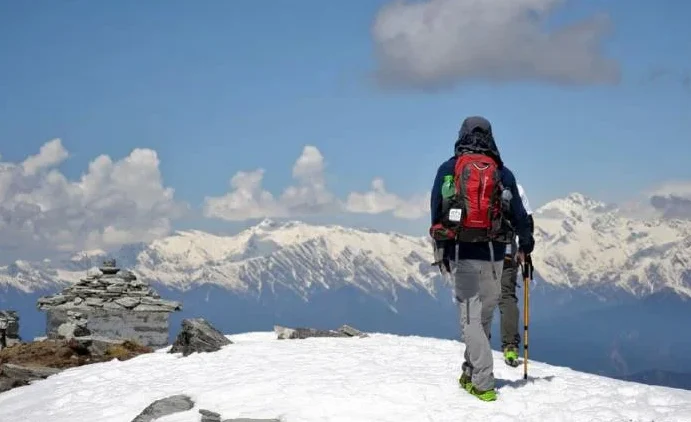
Discovering the Chopta Chandrashila Trek
Set in the beautiful Garhwal region of Uttarakhand, the trek to Deoriatal Lake is the best way to start the journey to the Chandrashila trek. On this trek, you get a gradual ascent as you walk to the summit of Chandrashila. When you reach the top, you see amazing views of Nanda Devi and Chaukhamba peaks. This trek is known for its rich natural beauty. As you go, you walk through lush green meadows and dense forests. You get to see the rich flora and many animals in the Kedarnath Wildlife Sanctuary. This trail is great for nature lovers and people looking for peace. The whole experience really shows what Himalayan treks are about.
Where Is Chopta Chandrashila Located?
Chopta Chandrashila is located in the Rudraprayag district of Uttarakhand, India, and lies within the scenic Kedarnath Wildlife Sanctuary. This beautiful region sits at an altitude of approximately 2,680 meters above sea level and is surrounded by dense forests of oak, pine, and rhododendron. From here, you’re treated to breathtaking panoramic views of some of the most iconic Himalayan peaks, including Nanda Devi, Trishul, Kedarnath Dome, and Chaukhamba. Chopta serves as the base for the Chandrashila summit trek and is also the starting point for other popular treks such as Tungnath—the highest Shiva temple in the world—and the peaceful Deoriatal Lake.

What Makes This Trek Unique in Uttarakhand?
The Chopta Chandrashila trek is one of the best treks in Uttarakhand. You will see great wide views of the mountains, and this place has a calm feeling with its ancient Tungnath temple believed to be over 1,000 years old. There are many types of plants and animals here, as the trail passes through the rich ecosystem of the Kedarnath Wildlife Sanctuary.
You can also visit the beautiful Deoriatal Lake, known for its mirror-like reflection of the Chaukhamba peaks. The combination of spiritual significance, natural beauty, and panoramic views makes this trek stand out. It’s a rare trail where you can walk through snowy paths, dense forests, and open meadows all in a single journey. The Tungnath temple, Chandrashila summit, and Deoriatal Lake together make this trip truly unforgettable for trekkers of all kinds—whether you’re seeking adventure, peace, or both.
Panoramic Himalayan Views from the Summit
The summit of Chandrashila offers one of the most soul-stirring views in the Indian Himalayas. From this high point, you can witness legendary peaks like Nanda Devi and Chaukhamba soaring into the sky. It’s a photographer’s paradise, where every frame captures the magnificence of nature.
As the day draws to a close, the fading sunlight paints the snow-covered landscape in brilliant hues of orange and pink, creating a truly magical atmosphere. Many trekkers pause here not just to admire the beauty, but to feel a deep emotional connection with the mountains. The peaceful silence at the top has a way of grounding you, making this a moment you carry long after the trek ends.
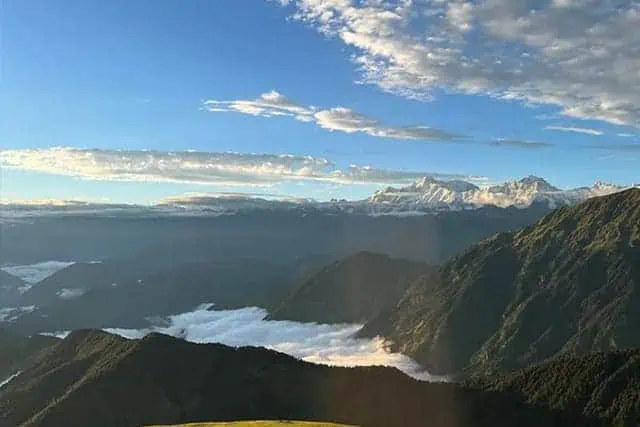
Tungnath Temple: A Sacred Journey
Perched at 3,680 meters, Tungnath Temple holds the distinction of being the highest Shiva temple in the world. Surrounded by rolling meadows and towering Himalayan peaks, the temple exudes a spiritual stillness that attracts both pilgrims and trekkers. The crisp mountain air and the majestic view of Chaukhamba in the backdrop add to its mystique.The Tungnath Temple trek offers a spiritual journey through breathtaking Himalayan landscapes to the world’s highest Shiva shrine.
For many, visiting Tungnath is not just part of the trek—it’s a deeply personal journey. The ancient stone structure, tucked away in a quiet mountain pass, feels timeless. Some come seeking blessings, others come to reflect and reconnect with themselves. Whether spiritual or not, anyone visiting this spot feels a profound sense of peace and awe.
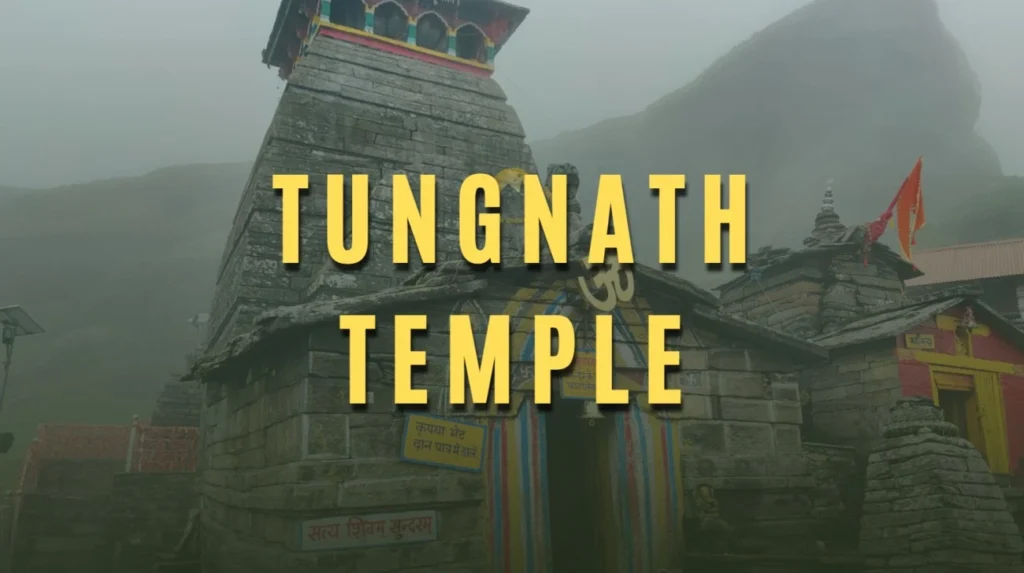
A Trail Full of Life: Flora and Fauna
The Chopta Chandrashila trek is not only about mountains and views—it’s a vibrant walk through one of Uttarakhand’s richest ecological belts. Along the trail, thick forests of deodar, oak, and pine open up to colorful meadows. Spring fills the region with blooming rhododendrons, turning the hillsides red and pink in vibrant waves.
This biodiversity hotspot is home to several rare species. Birdwatchers often spot the Himalayan monal—the state bird of Uttarakhand—and other species like the snow partridge and Himalayan woodpecker. The forested sections also shelter foxes, musk deer, and even leopards, though sightings are rare.
Every step of the trail brings a chance to witness nature’s variety, making it a haven for nature enthusiasts. The rich flora and fauna don’t just enhance the trek’s beauty—they sustain the fragile ecosystem and add depth to the entire experience. All of this together makes the journey through Chopta and Chandrashila not just scenic, but also incredibly enriching.
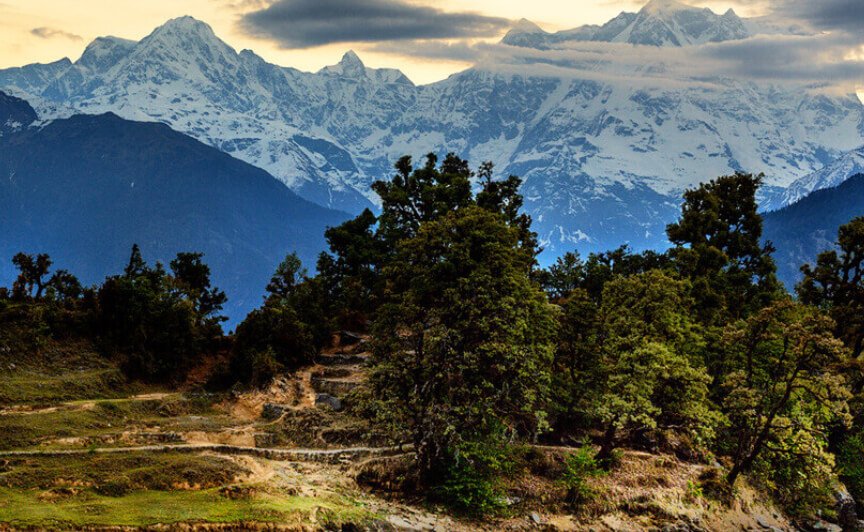
Deoriatal Lake – The Enchanting Starting Point
The trip to Deoriatal Lake is the starting point for your Chopta Chandrashila trek. Deoriatal Lake shines like a green jewel in the middle of thick trees. You can see tall Himalayan peaks behind it, including Chaukhamba. This calm lake has some of the best scenic beauty you will find. Trekkers love to watch how the mountains reflect in the clear water. It makes the view look even better. As you spend time at the lake, you may see rich flora and all kinds of wildlife. All of this adds to the magic of the place. This beautiful and quiet spot sets the tone for an unforgettable journey on the Chandrashila trek.
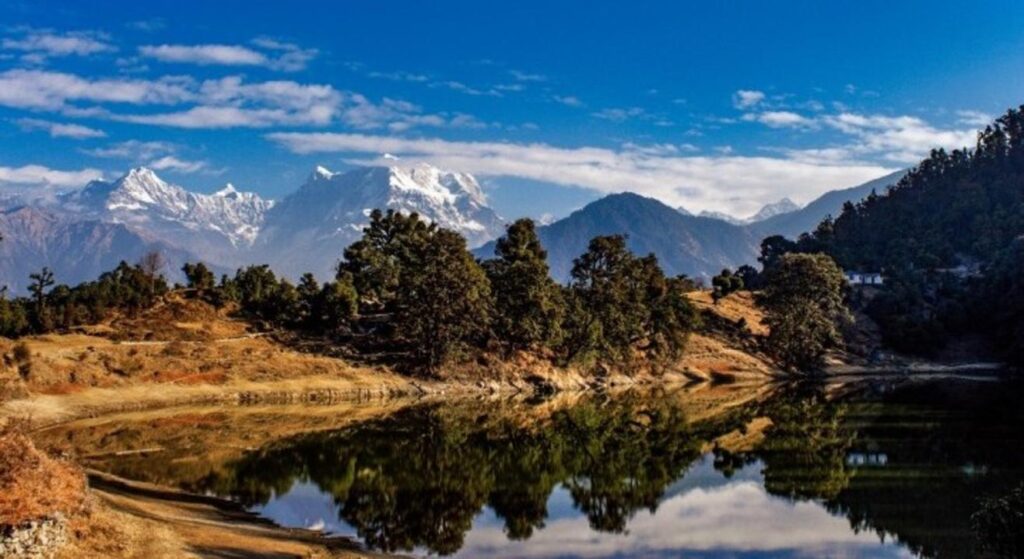
Best Time to Embark on the Chopta Chandrashila Trek
The best time to go on the Chopta Chandrashila Trek is in the spring or autumn. During these months, you will see lush green meadows and rich flora all around you. The weather conditions are nice and mild, so it is a great time to be outside and walk. You will get to look at the beautiful Himalayan peaks, like Nanda Devi and Chaukhamba.
If you choose to visit in the winter months, you will find that the place turns into a white wonderland. This is perfect for people who want a winter trek and to see the snow. The beauty of the Himalayas in these seasons is very special. No matter when you visit, make sure you know your fitness level and are ready for changes in temperature so you can fully enjoy your time there.
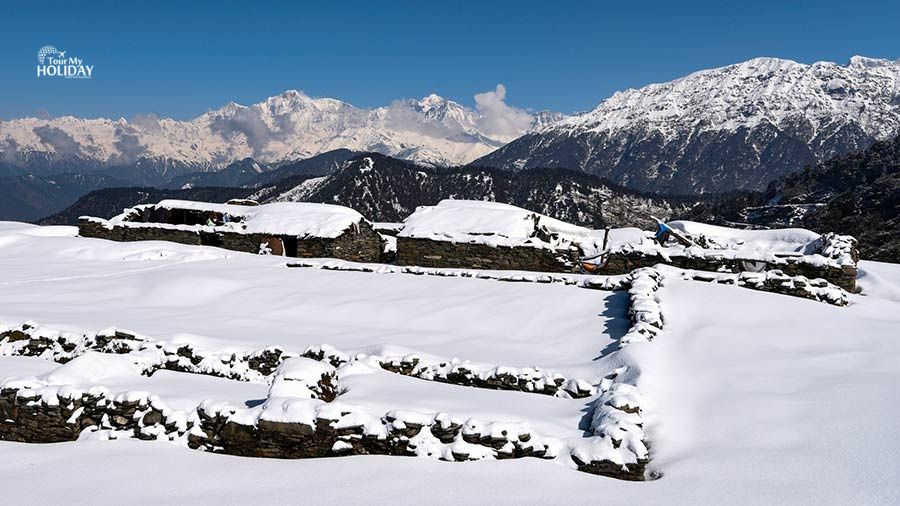
Seasonal Weather Overview
The weather in the Chopta Chandrashila region varies beautifully with each season, offering a unique experience throughout the year. Spring and early summer bring a burst of life to the trail, with pleasant temperatures, clear skies, and hillsides covered in blooming rhododendrons and alpine flowers. The meadows turn lush green, making it a perfect time for camping and photography. The crisp mountain air during this period makes every step refreshing and enjoyable.
As autumn arrives, the landscape transforms into golden tones. The skies are usually the clearest during this time, offering some of the best panoramic views of high-altitude Himalayan peaks like Nanda Devi, Chaukhamba, and Trishul. The temperature begins to drop slightly, creating a perfect balance between cool days and chilly nights—ideal for trekking without the summer crowds.
Winter brings with it a completely different charm. From December to February, the entire region is blanketed in thick snow. Chopta turns into a magical white paradise, attracting adventure lovers who come to experience snow trekking and the raw beauty of the mountains in their most silent and powerful form. The path to Tungnath and Chandrashila becomes more challenging, but for many, the snow adds a sense of excitement and solitude that’s unmatched.
Advantages of Trekking in Spring, Summer, Autumn, and Winter
Each season has its own special look and feel for the trek. In spring, you can see bright rhododendrons and alpine flowers, which stand out against the lush green meadows. It really brings out the beauty of the Himalayas. During summer, the sky stays clear and the weather is mild. This makes it a good time to get used to the heights and enjoy exploring. Autumn comes with warm colors that fill the land and make your walk peaceful. The weather stays nice, so hiking is easy. But in winter, everything changes. The whole region gets covered in snow, and it looks just like a magic world. People who want adventure in the cold will love the snow on every peak. Each time of year is different, and it invites nature lovers to enjoy the Himalayas in their own best way.
Who Should Go on the Chopta Chandrashila Trek?
The Chopta Chandrashila trek is ideal for anyone who loves nature, seeks adventure, or is looking for a peaceful spiritual escape. Whether you’re a first-time trekker, a nature photographer, a family traveler, or a seasoned adventurer, this trail has something to offer everyone. The trek is considered moderately easy, which makes it accessible even to beginners with basic fitness. If you’re someone who enjoys quiet forests, panoramic mountain views, and culturally rich experiences like visiting ancient temples, this trek will leave you deeply satisfied.
Families with children, couples, and even solo travelers often choose this trail for its manageable terrain and scenic beauty. However, if older adults or younger children are part of the group, it’s important to take necessary precautions—such as proper layering, slow pace, and adequate hydration—to ensure comfort and safety. The altitude gain is gradual, but the final climb to Chandrashila can be steep, so listening to your body and resting when needed is key.
Ideal Age Groups and Fitness Levels
The trek calls to people of all ages. It draws in both young people and adults who want some adventure. Most who join the trek are between ten and sixty years old. This is fine as long as you have average fitness. There is a gradual ascent, so both new and experienced trekkers can take part. Families can use this time to get closer to each other.
Older people should think about their medical condition before joining in. You should get ready for this trip by doing some cardio and stretching. That will help you enjoy the trek more. Stay positive and join in at every step. This will help you and your group have an unforgettable journey through the beauty of the Himalayas.
Is It Suitable for Beginners and Families?
The Chopta Chandrashila trek is a good choice for beginners and families if they get ready for it in the right way. The path is not too hard. It is clear and easy to follow. The views you get on the chandrashila trek are amazing. You and your family will have a great time together. The trip brings people close by letting them enjoy nature and learn about the local way of life. This makes the trek very special for all of us.
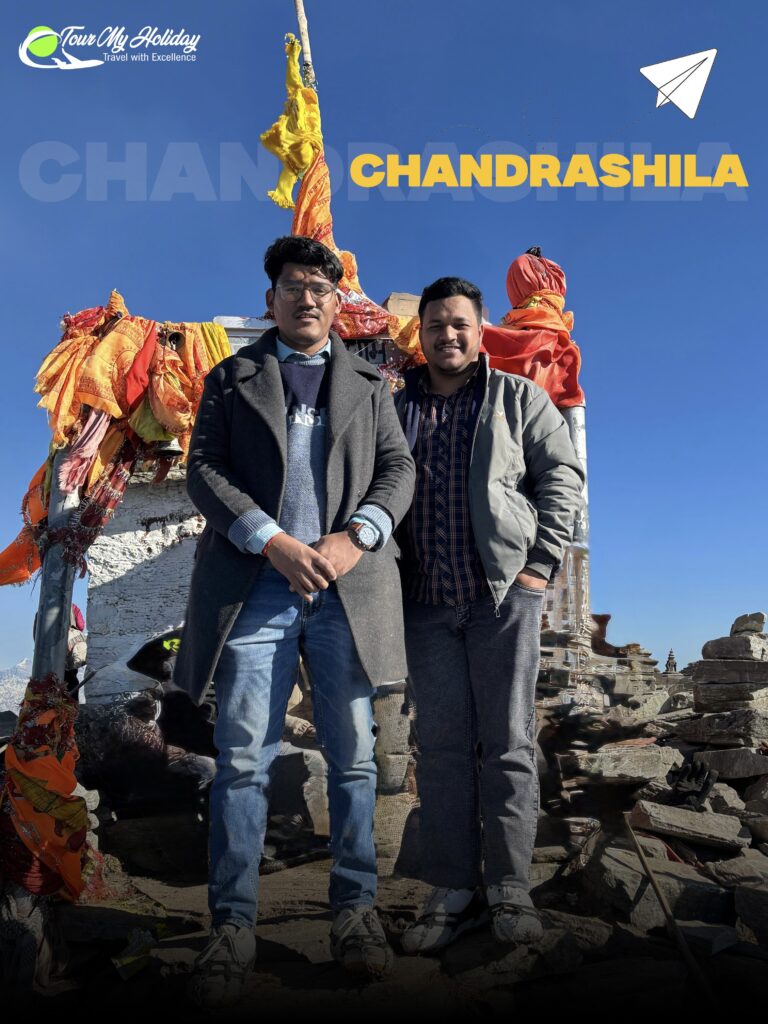
Special Considerations for Children and the Elderly
When planning a high-altitude trek like Chopta Chandrashila, it’s important to take extra precautions if children or elderly members are part of your group. Gradual ascent plays a crucial role in minimizing the risk of altitude sickness, especially for those with lower stamina or limited trekking experience. Taking regular breaks along the way not only helps the body adjust to changing altitude but also offers time to rest, rehydrate, and adapt to the varying weather conditions.
Hydration is key—make sure everyone drinks water consistently, even if they don’t feel thirsty. Carrying enough water bottles and a basic personal medical kit is essential for safety and quick response to minor issues. Proper clothing and equipment also make a big difference. Supportive, non-slip shoes are a must, as they provide stability on uneven and slippery mountain trails.
Additionally, having a professional trek guide or support staff can be very helpful. They are trained to handle emergencies, monitor the well-being of each group member, and offer guidance tailored to individual needs. Their presence not only adds a layer of safety but also helps everyone—especially kids and seniors—feel more comfortable and confident during the journey. With the right planning, gear, and support, the Chopta Chandrashila trek can be a memorable and safe experience for all ages.
How Difficult Is the Chopta Chandrashila Trek?
The Chopta Chandrashila trek is considered moderately difficult. It’s not too hard, but it does come with a few challenging sections. On average, you’ll be walking about 5 to 8 kilometers each day, with a total altitude gain of around 1,200 meters from the base to the summit. Some parts of the trail are rocky, uneven, and can get slippery—especially in snow or rain—so you’ll need to watch your step.
There are a few steep climbs, especially the final stretch from Tungnath to Chandrashila, which can be physically demanding. Having decent fitness and stamina is important to manage the ups and downs comfortably. If you walk regularly or have done short hikes before, you should be able to complete this trek with proper pacing and rest.
That said, the trail is well-marked, and many beginners complete the trek successfully with the right preparation. Carrying a light backpack, wearing proper trekking shoes, and staying hydrated make a big difference. With a bit of effort and enthusiasm, the Chopta Chandrashila trek is a rewarding experience for trekkers of all levels.
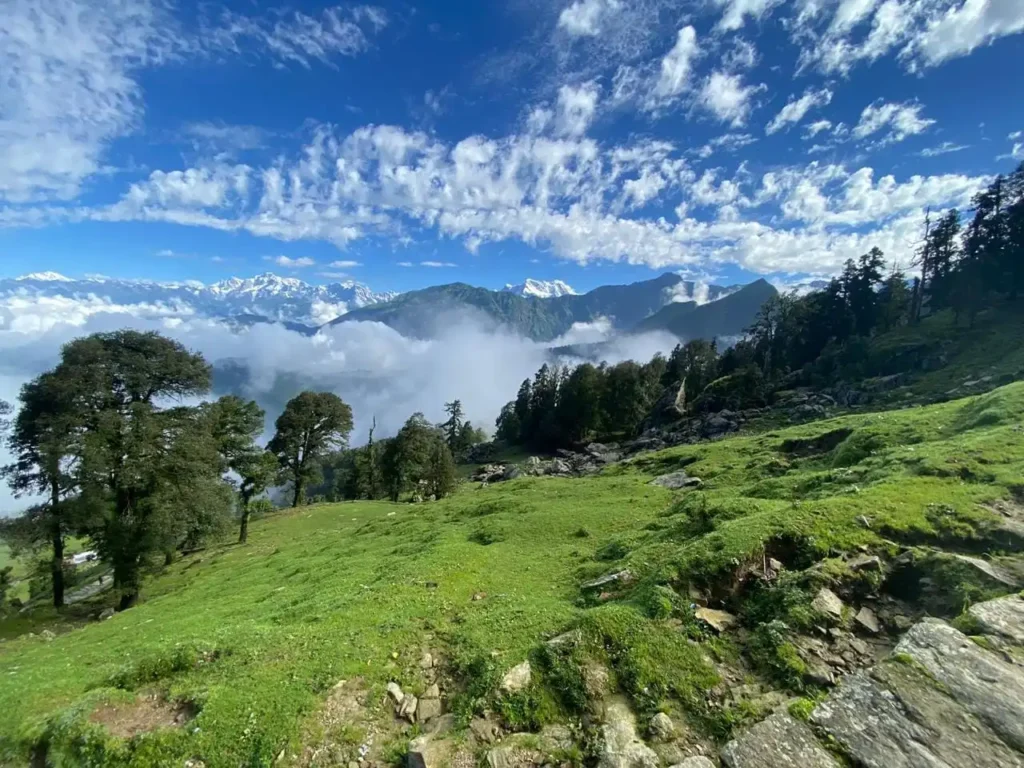
Beginner’s Guide: Preparing for the Chopta Chandrashila Trek
The Chopta Chandrashila trek is a perfect choice for beginners stepping into the world of Himalayan trekking. With a little preparation, you can turn this journey into an unforgettable experience filled with mountain magic, spiritual charm, and breathtaking views.
1. Physical Fitness Preparation
Before heading into the hills, it’s essential to prepare your body for the trek. Regular cardio exercises like brisk walking, jogging, or cycling can greatly improve your stamina. Strength training—especially for your legs and core—helps you handle uphill climbs and rough terrain with more ease.
Including stretching or yoga in your routine builds flexibility and lowers the risk of injuries. If possible, try doing short hikes or walks at moderate altitudes before your trip. This helps with acclimatization and makes your body more adaptable to the changing elevation.
2. Essential Equipment & Gear Checklist
Having the right gear is key to a safe and enjoyable trek. Here’s what you should carry:
- Clothing: Breathable base layers, a fleece jacket, waterproof outer shell, thermal innerwear (for winter), gloves, sun cap, and a woolen cap.
- Footwear: Trekking boots with good ankle support and solid grip.
- Accessories: Sunglasses, sunscreen, trekking poles, headlamp or flashlight, and wet wipes.
- Essentials: Lightweight backpack, personal medical kit, refillable water bottles or hydration pack, energy bars/snacks.
- Optional (if camping): Lightweight sleeping bag, compact tent, and extra batteries or power banks.
Dressing in layers allows you to adjust to changing weather conditions easily.
3. Important Documents to Carry
Administrative preparedness is just as important as physical readiness. Keep the following items in both physical and digital form:
- Valid government ID (Aadhaar card, driver’s license, or passport)
- Trekking permits (if required for the region)
- Copy of your itinerary and emergency contact details
- Travel insurance (preferably one that covers trekking or outdoor activities)
- Medical information card mentioning allergies, ongoing medications, or pre-existing conditions
Having these documents ensures smooth entry, access to care if needed, and peace of mind.
4. Budgeting and Cost Planning
Planning your expenses helps avoid last-minute surprises. Here’s what to include in your budget:
- Transport: Travel to and from Sari Village or Chopta (buses, taxis, etc.)
- Accommodation: Guest houses, homestays, or tents (prices vary based on season and preference)
- Food: Meals during the trek and at local dhabas
- Permits and Entry Fees: If applicable for protected areas
- Guide/Porter Fees: If hiring support staff
- Extras: Emergency buffer, first-aid items, and gear rental (if not carrying your own)
A well-planned budget ensures you’re covered and lets you enjoy the trip stress-free.
5. Tips for Packing and Trail Readiness
Start packing early and check weather forecasts before finalizing what you carry. Make sure your backpack is light but has all the essentials. Stay hydrated during the trek and eat energy-boosting snacks at intervals. Begin your days early so you can reach your destination before dark.
Must-See Attractions on the Trek
Set in the lovely area of Garhwal, the Chopta Chandrashila trek has many sights you should see. Deoriatal Lake is called the “mirror lake” because it shows the himalayan peaks in the water. This is one of the best spots for nature lovers. Tungnath temple sits here as well. It is the highest shiva temple in the world. The place gives you a peaceful feeling with the mountain views all around.
When you walk up to Chandrashila Peak, it feels like an unforgettable journey. At the top, this main vantage point lets you see the beauty of the himalayas. From here, you get a full view of nanda devi and chaukhamba peaks. Adventurers love to come back to see this place during the year. The Chopta Chandrashila trek is sure to give anyone a good look at what the land can offer.
Deoriatal Lake – The Mirror Lake
Deoriatal Lake sits in the beautiful Garhwal area. This spot is more than just the starting point of a trek. People call it the “mirror lake” because its clear water shows off the amazing Himalayan peaks like Chaukhamba and Nanda Devi. The place is very calm and gives peace to nature lovers. It has a special spot where you can see the rich flora and enjoy the natural beauty around you. The quiet setting helps trekkers feel close to both the land and the spirit of Chopta Chandrashila. This all comes together to make the start of an unforgettable journey.
Tungnath Temple – The Highest Shiva Temple
Tungnath Temple sits high in the Garhwal region. It is known as the highest shiva temple in the world, at 3,680 meters. People from many places come for the gradual ascent up the mountain. The temple is famous for its stunning spot and also the beauty of the himalayas all around it. The air is full of old stories. There are carvings on the temple that show the area’s deep culture. When people trek up to tungnath temple, they get peace in their minds. They also get to see the wide view of mountains, with the Chaukhamba range standing proud in the back.
Chandrashila Peak – The Viewpoint of Legends
Chandrashila Peak is a special place in the Himalayas. Many people believe that Lord Shiva once meditated here. At the top, you get amazing views of the mountains around you, like Nanda Devi and the Chaukhamba range. The way up is a gradual ascent. You walk through lush green meadows and dense forests on the way, which makes you feel close to nature. This trek is not only a test for your body, but it can also touch you in a spiritual way. When you stand there in the morning or evening, you will see the sun paint the mountains with bright colors. This is a time when most people say the scene is one they will never forget. It is the kind of place that brings in everyone who loves nature or an adventure.
Forests, Meadows, and Wildlife
Towering pine trees and lush green meadows welcome you as you start on the trek to Chandrashila. These dense forests give shade and help many animals live here. As you walk, look out for the animals found high up in the mountains, like a musk deer. You may also see birds flying between the trees. In the warmer months, wildflowers cover the meadows and bring bright color against the lovely himalayan peaks behind them. All of nature works together here, making the place perfect for nature lovers. It is an unforgettable journey and a great way to explore the mountains.
Flora and Fauna of the Region
The many kinds of plants and animals in the region add a lot to its lovely look and rich life. When you trek through the dense forests, you can see bright rhododendrons and alpine flowers. These flowers cover the meadows with amazing colors. People who love birds will be happy to spot many kinds of birds here. Their sounds fill the air as you walk. You might also spot wildlife like the secretive Himalayan black bear and musk deer while in the Kedarnath Wildlife Sanctuary. This special mix of life makes the trek even better and shows why it is important to protect this natural place for those who come after us.
Alpine Flowers and Rhododendrons
The bright colors of alpine flowers and rhododendrons make the trek special. You will see these colorful flowers in the lush green meadows of Chopta. They show how different and rich the plants are in this area. In spring, the rhododendrons look amazing in shades of red and pink. Their beauty adds to the scenic beauty of the place and gives a home for local animals. As nature lovers walk along these flower-covered paths, they get a sensory treat during the unforgettable journey to the summit of Chandrashila. The rich flora here truly shows what makes the Himalayas so special.
Birds and Animal Sightings
People who explore the Chopta Chandrashila area often get to see many different kinds of wildlife. If you like birds, you may see the bright Himalayan Monal, which is the state bird of Uttarakhand. There are also many types of warblers whose sweet calls fill the air. The area is also home to some rare animals like the Musk Deer and the Himalayan Tahr. These animals help make the place’s animal life rich and interesting.
Walking through the dense forests and lush green meadows, you get to see how these animals and their home fit well together. This adds to an unforgettable journey for all nature lovers who want to trek in the heart of the Himalayas.
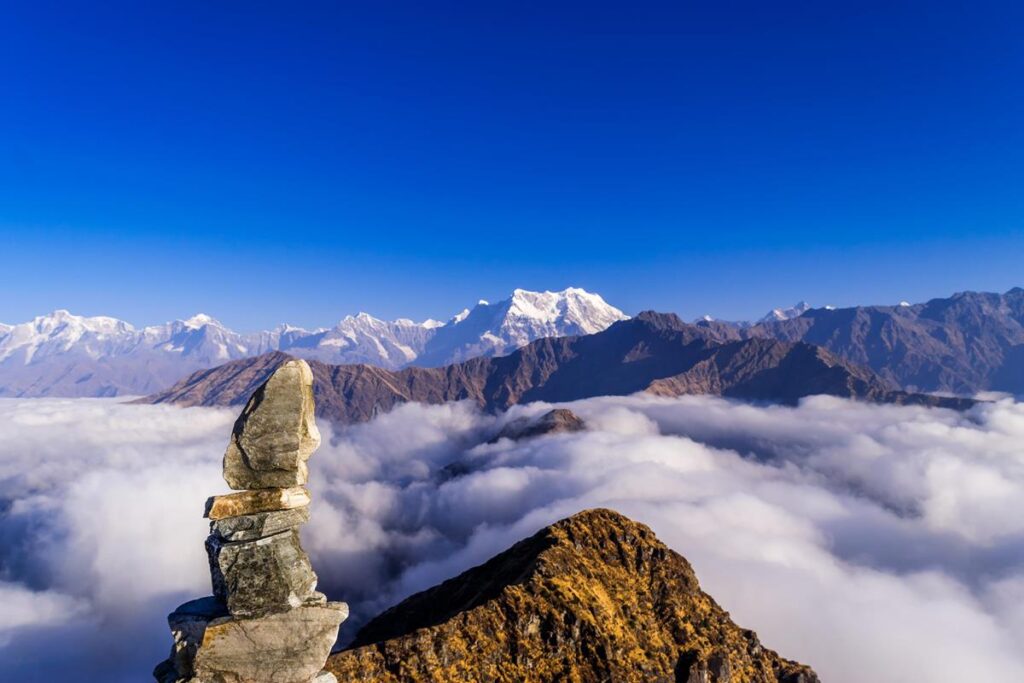
Responsible Trekking and Eco-Friendly Practices
Embracing responsible trekking and eco-friendly practices is key to keeping the amazing beauty of this area. People who like trekking should follow the ‘Leave No Trace’ rules. They need to take away all waste, such as plastic and food scraps, from the trails. Using products that break down in nature and eco-friendly things like wet wipes can help lower damage to the environment. When you choose to connect with local guides, you support these communities and make your trek better. This also helps keep tourism helpful for people who live there. Taking care when planning your group size and your trip plans will stop trails from getting too crowded. You can make your time here an unforgettable journey through Uttarakhand’s clean and special places, while still looking after them for others to enjoy later.
Leave No Trace Principles
Keeping the natural beauty of the Chopta Chandrashila trek safe is very important. By following the “leave no trace” rules, you help keep the area clean and healthy. Always take all your trash with you, even things you think will break down, like food waste. Do not bother the plants and animals you see along the way. Walk only on the paths that are marked to protect the natural areas, especially when you are in the Kedarnath Wildlife Sanctuary.
Bring and use reusable water bottles to help cut down on plastic waste. Pay attention to campfire rules while you are there. Also, be careful and respectful around wildlife. This not only makes your trek better, but it also keeps the natural beauty for all the people who will visit in the future. Enjoy the Chandrashila trek and help protect its beauty for years to come!
Supporting Local Communities
Helping out in local communities while you trek keeps the scenic beauty of the Himalayas safe. It also makes sure this beauty of the Himalayas does not fade. When you walk with local guides, you get a better trip. You also help villages like Sari and their people by giving them more money. If you buy homemade goods and local food, you help farmers and artisans keep up their work and skills. Joining community activities helps protect the area’s rich flora and animals. This way, the place stays green and clean. When you pick to trek with care, you help the region and its future. You are not just a traveler. You become someone who helps the area grow. Both you and the people who live there get something good from this.
Plan Your Escape with a Chopta Tour Package and Chandrashila Trek from Delhi
If you’re looking for a hassle-free getaway to the Himalayas, opting for a well-planned Chopta tour package is a great idea. These packages often include transport, meals, accommodation, and guided treks—making it ideal for both beginners and experienced trekkers. For adventure enthusiasts based in the capital, the Chopta Chandrashila trek from Delhi offers an exciting weekend escape filled with panoramic mountain views, ancient temples, and peaceful forest trails.
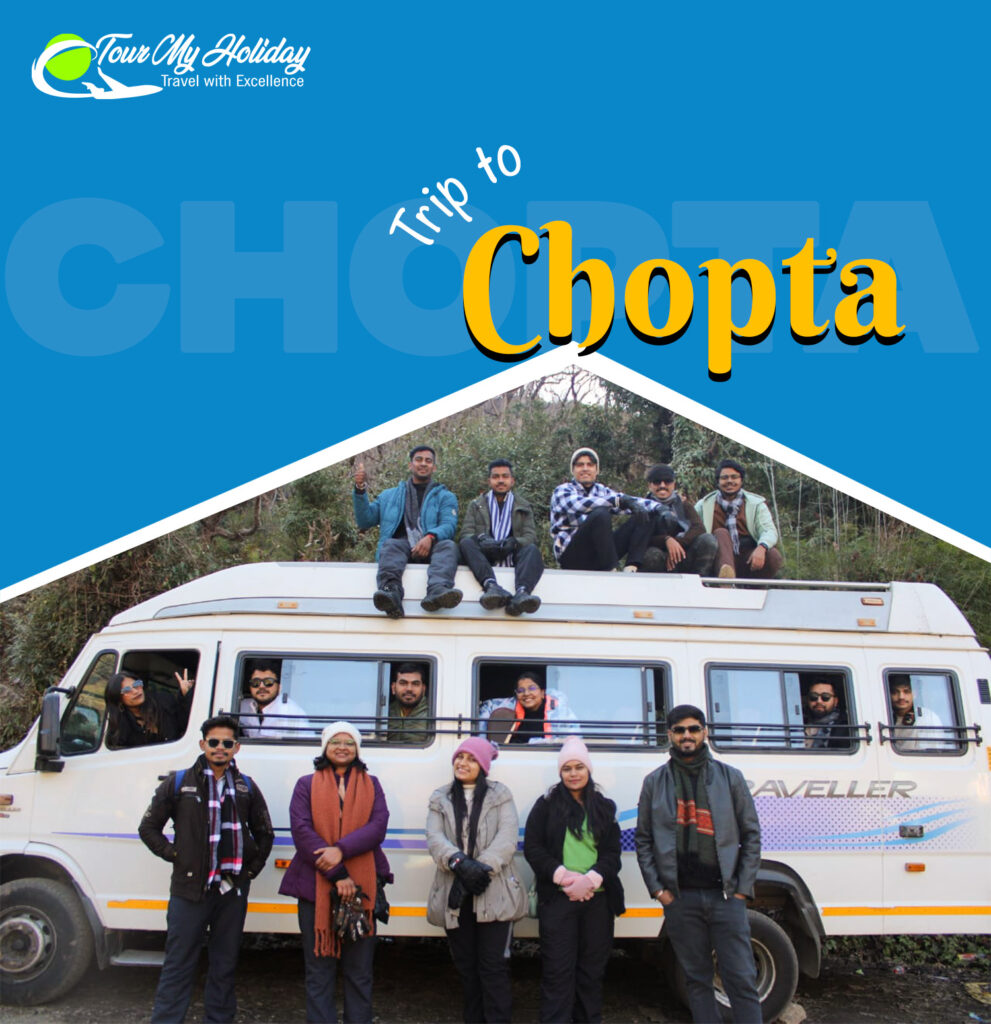
Frequently Asked Questions About the Chandrashila Trek
- Where is the Chandrashila Trek located?
The Chandrashila Trek is located in the Garhwal Himalayas of Uttarakhand, India. It starts from Chopta and goes via Tungnath Temple to Chandrashila summit. - What is the altitude of Chandrashila Peak?
Chandrashila Peak stands at an elevation of around 4,000 meters (13,123 feet) above sea level. - How difficult is the Chandrashila Trek?
The trek is considered moderate, suitable for beginners with basic fitness and some prior hiking experience. - What is the total distance of the trek?
The trek covers approximately 9–10 km round trip from Chopta to Chandrashila and back. - What are the main attractions of the trek?
Key highlights include Tungnath Temple, Chandrashila Summit, and stunning views of Himalayan peaks like Nanda Devi, Trishul, and Chaukhamba. - What is the best time to do the Chandrashila Trek?
The best time is March to June and September to November. It’s also popular in December for snow treks. - Can the Chandrashila Trek be done in winter?
Yes, the trek is accessible in winter, but expect heavy snow, especially from December to February. Proper winter gear is essential. - Is it safe to trek to Chandrashila alone?
Yes, solo trekking is generally safe if you’re experienced and well-prepared. However, going with a group or guide is recommended, especially in winter. - Do I need a guide for this trek?
While the trail is well-defined, hiring a local guide enhances safety and experience, especially in bad weather or if you plan to extend the trek to Deoriatal. - How to reach Chopta, the base for the Chandrashila trek?
Chopta can be reached via road from Rishikesh, Haridwar, or Dehradun. The nearest railway station is Haridwar, and the closest airport is Jolly Grant (Dehradun). - Is prior trekking experience required?
No, but having basic fitness and some trekking exposure helps, especially for the final steep climb to Chandrashila. - Is camping allowed on the trail?
Yes, camping is allowed near Chopta and Deoriatal. Some areas near Tungnath are restricted due to temple and forest regulations. - What kind of accommodation is available in Chopta?
You can find guest houses, homestays, and campsites in and around Chopta and Sari village. - What should I pack for the trek?
Essentials include trekking shoes, warm layers, a rain jacket, a backpack, water bottles, a first-aid kit, and necessary ID documents. - Are there any permits required for the trek?
Usually, no special permits are required for Chopta or Chandrashila, but forest entry charges may apply at certain checkpoints. - Is the trek suitable for children and elderly people?
Yes, with precautions. Children above 7 and elderly people in good health can attempt it with proper acclimatization and guidance. - Will I get mobile network coverage during the trek?
Network is patchy. Some spots in Chopta may have BSNL or Jio signals, but expect no connectivity on the higher trail. - What kind of food is available during the trek?
Local vegetarian meals, like dal, rice, and roti, are available in Chopta and nearby dhabas. Carry dry snacks and energy bars for the trail. - Are washroom facilities available on the route?
Basic toilet facilities are available at Chopta. No permanent toilets exist en route to Tungnath or Chandrashila. Be prepared for minimal hygiene. - Can I combine Chandrashila with other treks?
Yes! A popular route combines Deoriatal Tungnath Chandrashila over 2–3 days, giving you a fuller trekking experience in the region.
